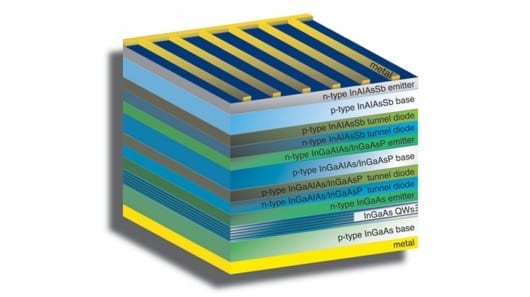
The current world record for triple-junction solar cell efficiency is 44 percent
U.S. Naval Research Laboratory scientists in the Electronics Technology and Science Division, in collaboration with the Imperial College London and MicroLink Devices, Inc., Niles, Ill., have proposed a novel triple-junction solar cell with the potential to break the 50 percent conversion efficiency barrier, which is the current goal in multi-junction photovoltaic development.
The current world record for triple-junction solar cell efficiency is 44 percent, but a collaboration between the U.S. Naval Research Laboratory(NRL), the Imperial College of London, and MicroLink Devices Inc. has led to a multi-junction photovoltaic cell design that could break the 50 percent conversion efficiency barrier under concentrated solar illumination.
Presently, the best examples of traditional silicon solar cells top out at around 25 percent efficiency, whereas multi-junction cells have achieved more than 40 percent. Multi-junction solar cells contain several layers of semiconducting material stacked one on top of another, each designed to absorb a different wavelength of light, thereby boosting their efficiency. On top, high band gap semiconductor material absorbs the short wavelength radiation, while longer wavelengths are absorbed by the layers below.
The key to the new multi-junction cell design was identifying what are known as “InAlAsSb quaternary alloys” as a high band gap material that can be grown lattice-matched to an indium phosphide (InP) substrate. Used in the team’s multi-junction solar cell, the alloys could achieve a maximum direct band gap of 1.8 electron volts (eV), which is higher than commonly used materials that, when lattice-matched to InP, result in a maximum of 1.4 eV.
“This research has produced a novel, realistically achievable, lattice-matched, multi-junction solar cell design with the potential to break the 50 percent power conversion efficiency mark under concentrated illumination,” said Robert Walters, Ph.D., NRL research physicist.
Read more . . .
via Gizmag – Jason Falconer
The Latest Streaming News: Triple-junction solar cell updated minute-by-minute
Bookmark this page and come back often
Latest NEWS
Latest VIDEO







